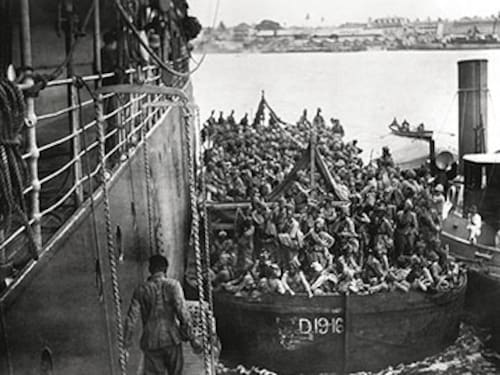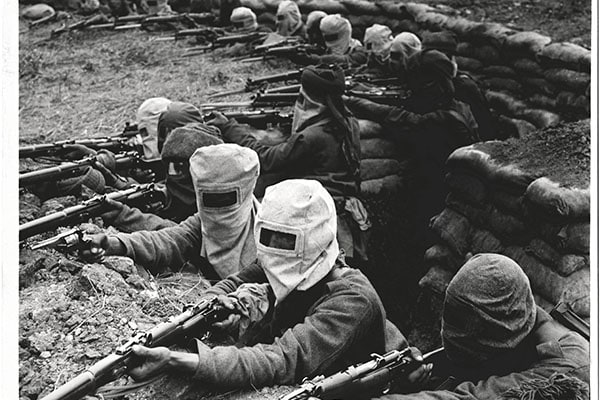The forgotten Indian heroes of World War
For a country whose role in the First World War is scarcely recognised, it still boggles the mind that, a hundred years ago, a mercenary army of over a million Indians left their farms and jobs to fig


If I should die,
think only this of me:
That there’s some corner
of a foreign field
That is for ever England.
– Rupert Brooke, war poet
If I die here,
who will remember me?
– A wounded Sikh soldier writing home to his father
Consider the quotes printed above. Two soldiers of the First World War contemplate the possibility of death in a foreign land. Though their theme is similar, their outlook is strikingly different. The first is the celebrated English poet-solider Rupert Brooke, and the second, a nameless sepoy. Brooke’s elegant lines, taken from his famous sonnet ‘The Soldier’, would become emblematic of the fate of millions of young Englishmen slaughtered inelegantly by machine-gun fire and poison gas in the killing fields of France and Flanders—indeed, the resonance of these lines has become so universal that in 2002, historian Ramachandra Guha borrowed the phrase “A corner of a foreign field” for the title of his social history of Indian cricket. Though Brooke’s verse is poignant, one can’t help compare its high romance and genteel glory-seeking to the desolation that suffuses the words of the Sikh solider. Sequestered in a cold and unfamiliar country away from his family and customs, his anonymity is absolute. He fears not death but existential oblivion, the prospect that he will die unmourned and that all memory of him will be wiped from the face of the earth. The profound contrast between the quiet confidence of the English soldier and the piercing loneliness of the Indian one goes to the heart of the mixed legacies of the Great War. The Sikh soldier’s fears proved prophetic. India’s seminal role in the First World War has remained steadfastly unsung—a narrative shunned both by India’s nationalist history books and by Europe’s Eurocentric ones. Today, few Indians know—or care—that the imposing arch of India Gate in Delhi was erected in memory of those killed in that war.
Memory, they say, is a form of justice—which probably explains why there is so little of it going around. Determined to memorialise India’s contribution to this European war is writer Vedica Kant, who has, fittingly enough, chosen the Sikh soldier’s quote as the sub-title of her book, India and the First World War. Published last year by Roli Books to coincide with the centenary of the war (1914 to 1918), this thickly illustrated and well-researched tome is riveting, both for its lavish photographs and cartoons as well as its insightful analysis of the political, cultural and social ramifications that the Great War had on India. Kant provides the broad view as well as the quirky detail, such as the fact that 62,000 tins of coconut oil were exported to Europe for the Indian soldiers to cook with and lubricate their hair. No olive oil, thank you very much. There are also numerous anecdotes of individual soldiers, including the charming one of Mohamed Khan, a trooper who wrote home announcing his marriage to a French woman. When his family responded with fury, Khan coolly replied that the King had commanded him to marry. Stories like this humanise and flesh out what would otherwise be a simplistic, one-track account of suffering in the trenches. Though the hellish frontline conditions are evoked in unflinching detail, the holistic nature of the war experience that Kant offers is one of the main strengths of the book.
One hundred years later, it still boggles the mind that a mercenary army of over a million Indians, many of them semi-literate, left their farms and jobs to cross the dreaded kala pani in order to fight in Europe, the Middle East, Africa, and on the high seas. Of all the British colonies that sent up contingents, India’s was the largest: 1.6 million men (soldiers, labourers, porters, bhistis, mule drivers, cooks) along with 170,000 animals (horses, elephants, mules), and a war chest of close to 200 million pounds. Over 70,000 Indians died, the rest returned, transformed in different ways by the crucible of conflict.
All manner of questions leap to mind: What made these young men enlist? What was it like for them to see snow for the first time and experience the twin shocks of a brutal winter and industrial warfare in freezing, muddy trenches? What was it like for them to shoot at white men and be referred to as barbarians and savages by more than one eminent German? What was it like for Indian Muslim soldiers to shoot at fellow Muslims (Turkish soldiers), given that the Ottoman Emperor had declared the war against England a jihad? What did the sepoys think of the women who walked about free, educated and unveiled? What did they eat and how were caste restrictions maintained? Did they, like the German soldiers in Erich Maria Remarque’s classic war novel All Quiet On The Western Front, endlessly play cards to kill the boredom? And did they, like the soldiers in Wilfred Owen’s eviscerating gas poem, fumble to put on their clumsy gas masks when the lethal chlorine gas poured into their dugouts? Were they terrified and homesick through it all or was there also a sense of adventure, a pride in trouncing the enemy? Did they know their letters were being censored? And when they eventually returned to their home villages in Punjab, Rajasthan, Lahore, Nepal, and other Northern parts —the British recruited only the so-called “martial races” such as the Sikhs, Gurkhas, Pathans and Punjabi Muslims—what did it feel like to be colonised, after having fought shoulder to shoulder with their coloniser? 
Signing up for trauma: A key incentive in raising a mercenary colonial army was the lucrative salary on offer—Rs 18 per month, roughly Rs 25,800 today
All these questions, and many more, are asked and answered, concisely but succinctly. (To get a more scholarly view of the war contribution of the other colonies as well as India, read Race, Empire and First World War Writing edited by Santanu Das.) Kant weaves together a wealth of archival material including thousands of letters written by the men to their families and voice recordings of the sepoys made by German philologists at their prisoner of war camps. These recordings are poignant and fascinating, containing snatches of songs and mantras. One recording has a man named Mall Singh stating: “Germany captured this man. He wishes to return to India.” Far more explicit is Havildar Abdul Rahman, who wrote to a friend, saying: “For god’s sake don’t come, don’t come, don’t come to war in Europe.” The sepoys’s letters are full of earthy metaphors used to describe the war: “The corpses cover the country like sheaves of harvested corn,” wrote one, while another described the incessant machine-gun shelling as an endless downpour of hailstones. The Mahabharata was invoked to explain the political hostilities between England and Germany: As one solider sagely argued, although the kings of the two warring countries were cousins—the descendants of Queen Victoria—weren’t the Kauravas and Pandavas cousins too? And everyone knows how that ended.
Kant also quotes from, and gratefully acknowledges, two invaluable original sources: The letters of a Bengali doctor, Captain Kalyan Mukherji, and the diaries of a stretcher-bearer, Sisir Sarbadhikari. Both men were sent to Mesopotamia, the theatre of war with the largest Indian military presence. Through Sarbadhikari’s jottings, one gets a sense of the institutionalised racism practised against the Indian troops—they were made to sleep on the exposed upper deck, given molasses and not sugar for their tea, paid half the salary of a British soldier, had different uniforms, and could never hope to rise beyond a certain position. This last inequity was a source of deep resentment, and considered an affront to their izzat or honour. They had reason to feel betrayed, since the recruitment posters had promised “a lot of izzat” and “very little danger”. The reality, however, turned out to be quite the opposite. Sarbadhikari also comments on the empathy that sprang up between the Turks and Indians despite the fact that they were enemies. Most crucially, one gets a visceral sense of the depravity of war, the hunger and exhaustion that drove many to suicide. Indeed, to read Sarbadhikari’s account of men marching asleep and without boots is to recall Wilfred Owen’s gas poem where ‘Men marched asleep. Many had lost their boots/But limped on, blood-shod. All went lame all blind’.
So why did these men sign up for such trauma? The main reason was the extraordinarily high salary (Rs 18 a month, roughly Rs 25,800 today) offered along with other monetary incentives. On a social and political level, too, they were strongly encouraged and often coerced into enlisting by the princely rulers and zamindars keen to ingratiate themselves with the Raj (even the notoriously stingy Nizam of Hyderabad was spurred into donating six million rupees to maintain two cavalry units in France). Congress leaders like Gandhi, Tilak and Sarojini Naidu also supported the war effort with Tilak saying, “Purchase war debentures but look at them as title deeds of Home Rule.” The thinking was that helping Britain in her time of need would help ease the path to self-government. As for the soldiers themselves, Kant suggests that while their loyalty to King George was very real and rooted in the ancient Indian concept of namak halali, they were also keenly aware of the ironic nature of their own situation as a colonial army fighting for the freedom of the coloniser.
The British, no doubt for purely strategic reasons, did what they could to make the Indian contingent comfortable. Great care was taken to observe dietary rules lest there be a repeat of 1857. There were separate butchers to ensure a supply of halal meat for Muslims, and during the disastrous siege of Kut in Mesopotamia, when food supplies ran out and the soldiers were reduced to skeletons, General Townshend got the imam of Delhi’s Jama Masjid and several granthis and pundits to sanction the consumption of horse meat. In England, the wounded were housed in a spectacular Indo-Saracenic pavilion in Brighton. Kant’s discerning eye, however, travels beyond the chandeliers and arches to the high walls around the hospital—a grim sign of how movement was monitored and mixing between the Indians and English women firmly discouraged. In France, however, the rules of social mingling were far more relaxed and more than one interracial romance sprang up.
Two quibbles: The book would have benefitted from sharper editing. The phrasing is sometimes clumsy and repetitive. And secondly, although this may sound whimsical, the role of Rudyard Kipling deserved more play. Not only did Kipling visit the wounded soldiers at Brighton, he was so spellbound by their letters that he asked for copies and wrote four fictional letters in a little-known book called The Eyes of Asia. It should also be noted that of all the war poets, it was only Kipling, the arch imperialist, who memorialised the contribution of India in verse.  Getting better: Wounded Indian soldiers were housed in a spectacular Indo-Saracenic pavilion in Brighton. But their movements outside were restricted and mingling with local women was strongly discouraged
Getting better: Wounded Indian soldiers were housed in a spectacular Indo-Saracenic pavilion in Brighton. But their movements outside were restricted and mingling with local women was strongly discouraged
His couplet, ‘Hindu Sepoy in France’, is a simple and dignified expression of gratitude that seems to speak directly to the trauma of men like the bereft Sikh solider who wondered what would become of him: This man in his own country prayed we know not to what powers./We pray Them to reward him for his bravery in ours.
In the excellent foreword to the book, Amitav Ghosh points out that though there are gaps in the narrative—such as the absence of the role of lascars, whose seaborne war effort was far greater than that of the sepoys on land—Kant’s remarkable achievement lies in evoking “the texture of the sepoy’s experience and of the conflicted, ambivalent cadences of his voice”.
As a writer whose works have persistently shone the spotlight on the uncelebrated men and women in history’s margins, Ghosh knows something about the stifled subaltern view. Which is what makes his concluding paragraph about the sepoy’s voice so moving: “It is a voice that cries out to be heard, precisely because its story does not conform to the mirrored Western narratives of victory and defeat: What it offers is the possibility of an alternative reading of that history—as a story both of the defeat-in-victory and victory-in-defeat. To my mind, this is closer to the truth of what happened on the battlefields of Europe and Asia during the First World War than many more familiar interpretations of those tragic events.”
First Published: Feb 07, 2015, 06:26
Subscribe Now(This story appears in the Apr 16, 2010 issue of Forbes India. To visit our Archives, Click here.)